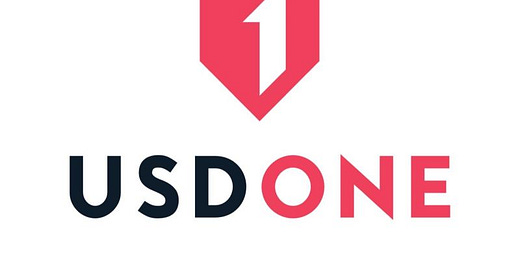Kinesis USD1, Third Largest Stablecoin in the World?
In December 2024, Kinesis claimed to have launched the world's third largest stablecoin with $15 billion USD in backing
Since its launch in December 2024, USD1 has attracted no exchange listings beyond Kinesis’ own exchange. USD1 is currently held by only 13 unique addresses and has less than 2,500 on chain transactions. USD1 is evenly split between the Ethereum blockchain and the Stellar blockchain with a circulation 6 billion tokens on each chain.
Despite its purported status as the third largest stablecoin in the world, and the 11th largest cryptocurrency overall (beating out Chainlink by nearly $1 billion), USD1 has attracted no mainstream media coverage.
Kinesis has been unable to hold USD1 to its $1 peg on either Stellar SDEX or their own exchange.
What proof does Kinesis offer of the $15 billion USD they claim is backing their $12 billion USD1 tokens? A single page letter from an unknown Texas attorney.
Let’s take a closer look at the attestation:
Lack of Specificity and Verifiability
The letter claims $15 billion USD is "blocked and available" at a "top 10 premier European Bank" to back Kinesis USD1, but it provides no specifics—no bank name, no account numbers, or any verifiable proof of funds. In financial attestations, especially for a $12 billion stablecoin like USD1, such vagueness is a glaring red flag. Legitimate attestations for stablecoins (e.g., USDC) name custodians like BNY Mellon or BlackRock and provide a detailed breakdowns of assets.
Without identifying the bank or providing a mechanism for independent verification (e.g., a public audit, bank statement), this claim is unverifiable and meaningless. It’s akin to a blank check—impressive on paper but worthless without substance. This mirrors historical stablecoin frauds like TerraUSD, where opaque reserve claims preceded collapse.
Excess Reserves
The letter claims $15 billion in reserves, exceeding Kinesis’s stated $12 billion USD1 circulation by an absurd 25% margin. While over-collateralization isn’t inherently suspicious (USDC only maintains $200 million in excess reserves for $56 billion tokens), the gap raises questions:
Kinesis’s December 2024 announcement claimed $15 billion in reserves for $12 billion in circulation, but no subsequent updates or detailed breakdowns have been provided. A second letter, dated January 20, 2025, repeats the figure without indicating any changes in circulation, redemptions, or reserve composition.
Stablecoins like USDC maintain reserves in highly liquid, diversified assets (cash, Treasuries, etc.), audited by Big Four firms. Here, the lack of asset detail (e.g., cash, cash equivalents, or illiquid holdings) and reliance on a law firm’s attestation rather than an accountant’s audit is highly irregular.
The repetition of a round $15 billion figure without evidence or updates suggests a static, fabricated number rather than a dynamic financial reality. It’s suspiciously convenient, especially given Kinesis’s history of opaque reporting with retards to its KAU and KAG tokens.
Legal and Regulatory Implausibility
The letter claims the funds are “clean, clear, and of non-criminal origin” with “no liens or encumbrances,” declared under penalty of perjury under Texas and U.S. law. However, a law firm attesting to the legality of funds isn’t standard practice for stablecoin reserves. Typically, banks or auditors provide such assurances, not attorneys, especially not for custodial backing of a digital asset.
Kinesis USD1 operates out of Australia and teh Cayman Islands, not Texas or the U.S., raising jurisdictional questions. Why would they rely on a Texas attorney for an attestation?
The legal language is performative but hollow, designed to impress rather than inform. It’s a common tactic in crypto scams to use U.S.-based legal jargon to mislead investors, especially given the lack of regulatory oversight in the Cayman Islands.
Kinesis’s Track Record
Kinesis’s past with KAU and KAG tokens shows a pattern of incomplete transparency. Audits for those tokens were sporadic, often performed by obscure entities (e.g., HititVal Cargo), and failed to tie physical assets to on-chain supply. If USD1 follows this pattern, this attestation from Herrscher Group fits the mold of a hastily assembled, untrustworthy document.
The letter aligns too neatly with Kinesis’s history of opaque reporting, suggesting it’s part of a broader strategy to create an illusion of credibility without any real substance.
Conclusion: This Attestation Is a Sham
This "Letter of Attestation" is almost certainly fraudulent or misleading, based on its unverifiable claims, obscure entities, and lack of specificity or regulatory adherence. It’s a textbook example of a crypto scam tactic—using legal-sounding language to lend false legitimacy to a stablecoin’s reserve claims. Kinesis’s USD1, already under scrutiny for its massive $12 billion launch and peg stability issues, now has an attestation that fails every reasonable test of credibility.
If this document were genuine, it would include:
A named, verifiable bank with a public statement or audit.
A reputable auditing or accounting firm, not a law firm.
Transparent details on reserve composition and liquidity.
This attestation is not just questionable, it’s almost certainly a complete fabrication.









